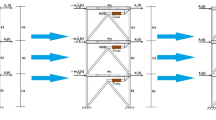Abstract
Studied are the hysteretic force–deformation response of large-scale nonlinear viscous dampers and model of the response for use in numerical simulations and seismic design. The force–deformation response of nonlinear viscous dampers with a force capacity of 600 kN are characterized under sinusoidal loading. A wide range of amplitudes and frequencies are used in the characterization tests. A nonlinear Maxwell model is presented for modeling the force–deformation response of large-scale nonlinear viscous dampers for use in nonlinear response history analyses. This paper also presents an equivalent linear model for the force–deformation response of a nonlinear viscous damper in-series with the elastic bracing and connection components needed to connect the damper to a building structure. The equivalent linear model enables the effects of the elastic flexibility of structural components on the response of the damper-brace component to be considered in seismic design. Results from tests on a 0.6-scale three-story structure with nonlinear viscous dampers validated the predictive accuracy of the equivalent linear model. Also evaluated are the effects of the elastic flexibility of structural components (e.g., bracing and connection) on the effective stiffness and damping ratio of a building structure with nonlinear viscous dampers.























Similar content being viewed by others
Data availability
The data used in the manuscript are available upon request.
References
ASCE (2016) Minimum design loads for buildings and other structures (ASCE/SEI 7–16). American Society of Civil Engineers, Reston, VA
Building Seismic Safety Council (BSSC) (2009) NEHRP Recommended Seismic Provisions for New Buildings and Other Structures: FEMA P-750/2009 Edition. Federal Emergency Management Agency, Washington, DC
Chen YT, Chai YH (2011) Effects of brace stiffness on performance of structures with supplemental Maxwell model-based brace–damper systems. Earthquake Eng Struct Dynam 40(1):75–92
Christopoulos, C. and Filiatrault, A. (2006). Principles of passive supplemental damping and seismic isolation. IUSS Press.
Dong B, Sause R, Ricles JM (2016) Seismic Response and Performance of a Steel MRF Building with Nonlinear Viscous Dampers under DBE and MCE. J Struct Eng. https://doi.org/10.1061/(ASCE)ST.1943-541X.0001482,04016023
Dong B, Sause R, Ricles JM (2018) Seismic Response and Damage of Reduced-Strength Steel MRF Structures with Nonlinear Viscous Dampers. J Struct Eng 144(12):04018221
Dong, B. (2016). Large-scale experimental, numerical, and design studies of steel MRF structures with nonlinear viscous dampers under seismic loading. PhD Dissertation, Lehigh University, Bethlehem, PA.
Fan, C.P. (1998). Seismic analysis, behaviour, and retrofit of non-ductile reinforced concrete frame buildings with viscoelastic dampers. Ph.D. Dissertation, Department of Civil and Environmental Engineering, Lehigh University, Bethlehem, PA.
Fu Y, Kasai K (1998) Comparative study of frames using viscoelastic and viscous dampers. J Struct Eng 124(5):513–522
Lee K-S, Fan C-P, Sause R, Ricles J (2005) Simplified Design Procedure for Frame Buildings with Viscoelastic or Elastomeric Dampers. Earthquake Eng Struct Dyn 34(10):1271–1284
Lehigh RTMD Facility (2014). Lehigh RTMD Users Guide (2014). https://www.rtmd.lehigh.edu/resources/users-guide.
Lin W, Chopra A (2003) Earthquake Response of Elastic Single-Degree-of-Freedom Systems with Nonlinear Viscoelastic Dampers. J Eng Mech 129(6):597–606
Sause R, Hemingway G, Kasai K (1994) “Simplified Seismic Response Analysis of Viscoelastic-Damped Frame Structures”, Proceedings, Fifth U.S. National Conf Earthquake Eng EERI 1:839–848
Singh MP, Verma NP, Moreschi LM (2003) Seismic analysis and design with Maxwell dampers. J Eng Mech 129(3):273–282
Soong TT, Spencer BF (2002) Supplemental energy dissipation: State-of-the-art and state-of-the-practice. Eng Struct 24(3):243–259
Symans MD, Charney FA, Whittaker AS, Constantinou CMC, Kircher A, Johnson MW, McNamara RJ (2008) Energy dissipation systems for seismic applications: current practice and recent developments. J Struct Eng 134(1):3–21
Takewaki I, Yoshitomi S (1998) Effects of support stiffness on optimal damper placement for a planar building frame. Struct Design Tall Build 7:323–336
Acknowledgements
The National Science Foundation under the George E. Brown, Jr. Network for earthquake engineering simulation research (NEESR) program is acknowledged for a grant (Award No. CMS-0936610) to support the experimental work performed at the NHERI Lehigh University Real-Time Multi-Directional (RTMD) earthquake simulation facility. The analytical work reported in this paper was performed by the first author and supported by grants from the National Natural Science Foundation of China (Award No. 52078385) and the Science and Technology Commission of Shanghai Municipality (Pujiang Program: 20PJ1414000). The opinions, findings, and conclusions expressed in this paper are those of the authors and do not necessarily reflect the views of those acknowledged here.
Author information
Authors and Affiliations
Corresponding author
Ethics declarations
Conflict of interest
The authors declare that there is no conflict of interest.
Additional information
Publisher's Note
Springer Nature remains neutral with regard to jurisdictional claims in published maps and institutional affiliations.
Rights and permissions
About this article
Cite this article
Dong, B., Sause, R. & Ricles, J.M. Modeling of nonlinear viscous damper response for analysis and design of earthquake-resistant building structures. Bull Earthquake Eng 20, 1841–1864 (2022). https://doi.org/10.1007/s10518-021-01306-7
Received:
Accepted:
Published:
Issue Date:
DOI: https://doi.org/10.1007/s10518-021-01306-7




